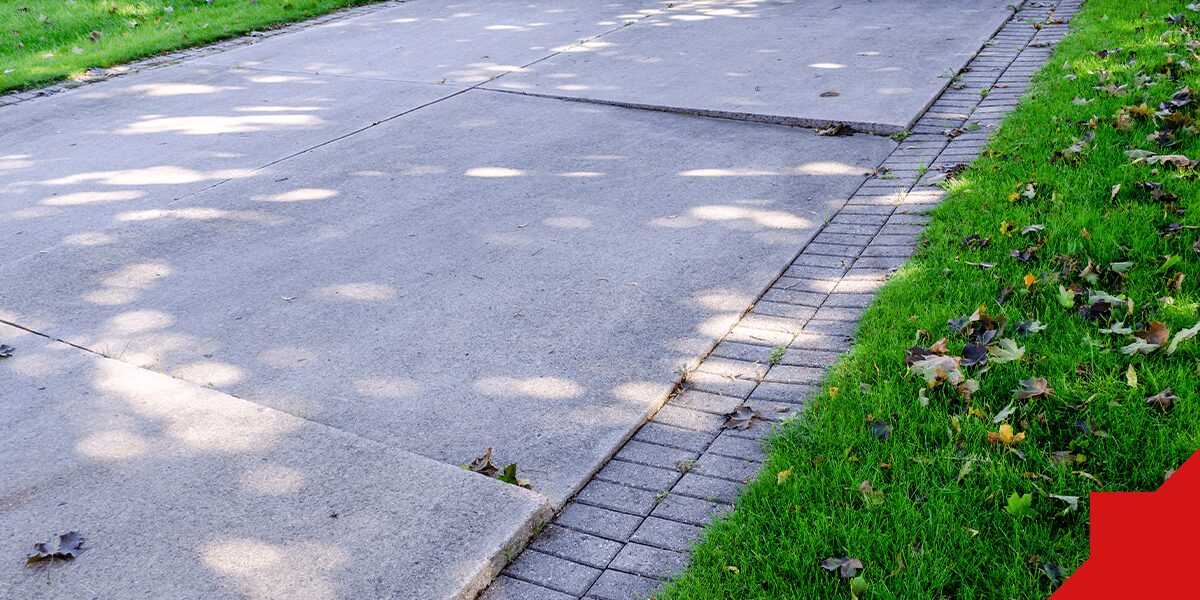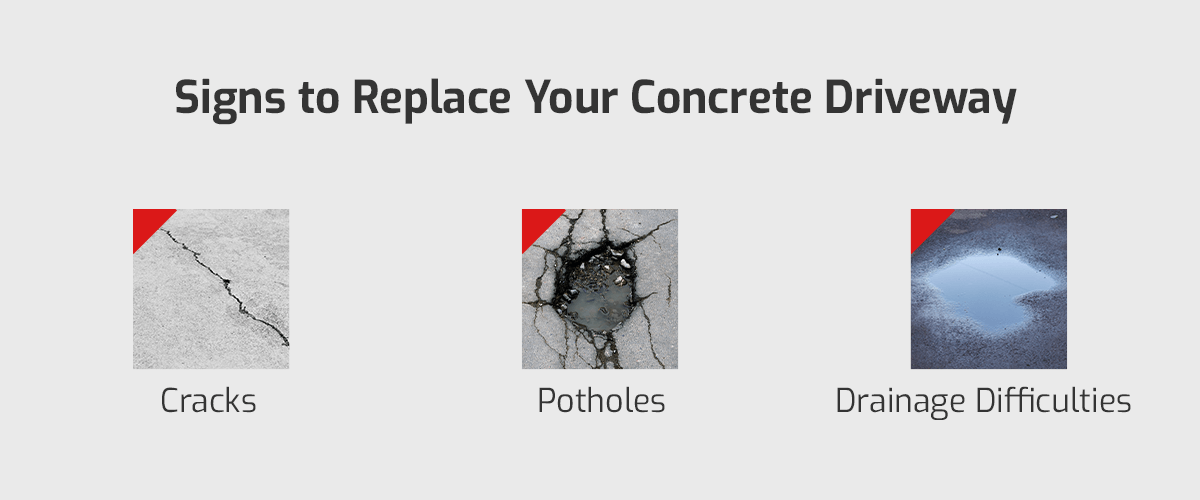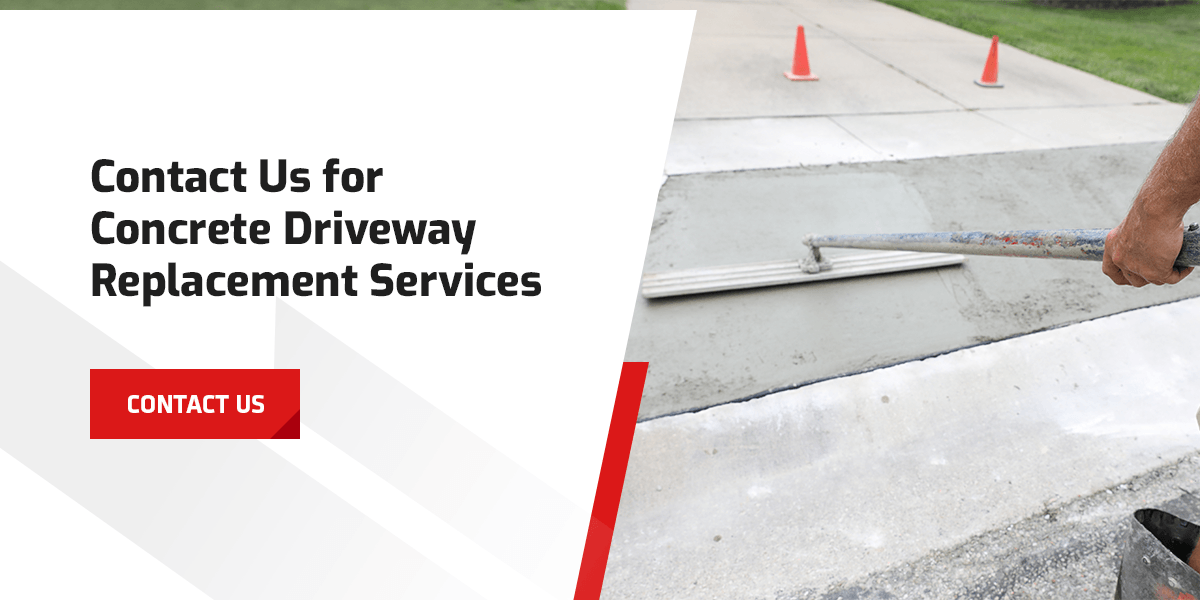HOW TO CLEAN A CONCRETE DRIVEWAY: THE ULTIMATE GUIDE

Many homeowners and businesses rely on sturdy concrete driveways. But over time, dirt, grease and mold can build up on these surfaces, causing unsightly stains and blemishes. The same goes for concrete floors in garages and warehouses.
Fortunately, you can easily remove these contaminants with the right techniques. Learn how to clean a concrete driveway in this handy guide.
Tips for Cleaning Concrete Driveways
Below are some recommendations for tackling common stains.
1. Dirt
Concrete driveways are bound to accumulate dirt and dust, especially with surrounding trees, soil and vegetation. You can typically use one of these tools to clean everyday dirt and grime from your concrete driveway:
- A power washer
- A garden hose with a spray nozzle
If using a power washer, avoid using a range that’s too close or an excessive PSI. This can damage the concrete. In most cases, a PSI of 2,500-3,500 should suffice. If you have little to no experience using a power washer, you can always hire a professional to handle this task.
2. Grease and Oil
Oil spills can be more stubborn than standard dirt and dust, so they often require a special cleaning method. If you’re wondering how to clean oil off your driveway, we’ll cover the steps for eliminating both new and old oil stains. Grab one of these cleaning agents before getting started:
- Sprayable oven cleaner
- Heavy-duty concrete degreaser
- Commercial oil stain remover
- Automotive brake cleaner
- WD-40
Follow these steps for removing a fresh grease or oil stain:
- Absorb the stain. Wipe up as much liquid as possible with a paper towel. Sprinkle sawdust, baking soda, cat litter or another absorbent material over the pool of oil. Let it sit for a few hours before sweeping up the debris.
- Wipe it up. Pour your cleaning solution of choice over the stain so it covers the affected area. Let it rest for about five minutes, then wipe it up with a rag. If your chosen solvent is ineffective, repeat the steps with a different product on the list until you find one that works better.
Old oil stains can be trickier than fresh ones, so removal may take some additional trial and error. We recommend these steps for removing an old grease or oil stain from a concrete surface:
- Wipe up the stain. Apply one of the suggested cleaning items to the stain, fully covering the impacted area. Let it sit for roughly five minutes before wiping it up with a rag.
- Scrub with soap and water. Gently trickle some grease-fighting dish soap over any lingering stain remnants. Then, pour hot water over the stained area and scrub it with a nylon or wire brush.
- Flush the area. Flush the entire region with boiling water and repeat these steps as needed. As with fresh stains, you can experiment with different cleaning solutions as necessary.
3. Tire Marks
When a hot tire’s plasticizers make contact with your concrete driveway sealer, it can cause discoloration and damage. If you spot pesky tire marks on your driveway, try scrubbing them with a stiff brush and concrete degreaser.
To prevent future tire marks, use a polyurethane or acrylic concrete sealer with a high solid concentration. This helps create a durable film that hinders plasticizer absorption.
4. Mold and Mildew
You might notice mold stains on your concrete driveway, especially if it’s in a moist, humid or shaded area. Concrete is porous, making it a hotbed for mold and mildew.
Luckily, fungal buildup is relatively quick and simple to remove. Try scrubbing the afflicted area with one of these solutions:
- A mold-killing detergent
- A water and bleach solution — about 1 cup of bleach per gallon of water
White distilled vinegar is another option to clean mold stains. However, use caution if you go this route. Vinegar is extremely acidic and can damage your driveway’s top cement layer or sealer.
Scrub vigorously to get down into the concrete’s pores. Then, rinse the area with a pressure washer to remove solid matter.
When scrubbing with bleach, remember to wear gloves to protect your skin. Additionally, avoid mixing bleach with other household cleaners. The chemical reactions can create toxic fumes.
To prevent future mold growth, seal your concrete driveway with a high-quality acrylic sealer. Let the surface dry for a couple of days in dry, sunny conditions before sealing.

Signs to Replace Your Concrete Driveway
In some instances, routine cleaning won’t cut it. Various factors can damage concrete driveways, warranting a repair or replacement. Some examples include:
- Improper maintenance. Concrete driveways should be resealed every one to three years to prevent pitting and cracks. If you don’t consistently seal your driveway, you may need to replace it sooner than anticipated.
- Natural wear. Concrete gradually degrades from foot and wheel traffic, weather conditions and the surrounding environment. Excessive wear and tear indicate the need for a replacement.
- Old age. Sometimes, a concrete driveway may need to be replaced simply because it’s too old. When installed on a stable foundation with good drainage, a concrete driveway usually lasts 30-40 years. If your driveway has advanced in years, consider swapping it out.
Below are some signs it’s time for a new concrete driveway.
1. Cracks
Small, minor cracks can typically be filled without requiring a total driveway replacement. However, multiple large, deep cracks are another story. Water, oil and other substances can also seep into the cracks and further damage the concrete. Call in a professional for driveway replacement if you notice severe fracturing.
2. Potholes
Large gaping holes in your concrete driveway may signify damage beyond repair. Aside from being an eyesore, potholes also pose various safety hazards, such as:
- Tearing or puncturing tires
- Damaging tire belts and sidewalls
- Affecting your vehicle’s alignment
Minor potholes can sometimes be filled. However, filling may not completely address the issue, as the hole can reopen as the ground contracts and expands. Replacing the driveway altogether is generally a safer bet.
3. Drainage Difficulties
A sloped or uneven driveway can cause drainage problems that can erode the concrete. If you notice standing water on your driveway, the concrete could be sinking. This is a serious issue necessitating a replacement.
Standing water can lead to cracks and potholes. Even worse, it can penetrate and weaken the building’s foundation. If you notice poor drainage, pooling water and sunken areas of your driveway, consult a professional for replacement immediately.
Contact Us for Concrete Driveway Replacement Services
If you’re seeking a new concrete driveway for your home or business, R. J. Potteiger Construction Services, Inc. is up to the task. We provide high-quality concrete driveway repair and replacement services throughout Pennsylvania.
With over 30 years in business, we’re well-equipped to restore your residential or commercial driveway to its former glory. Contact us to schedule your concrete driveway replacement today!




